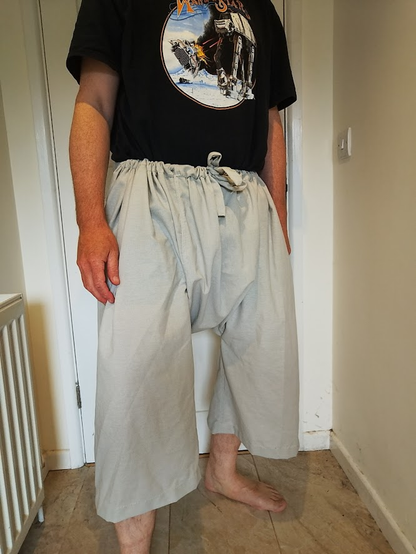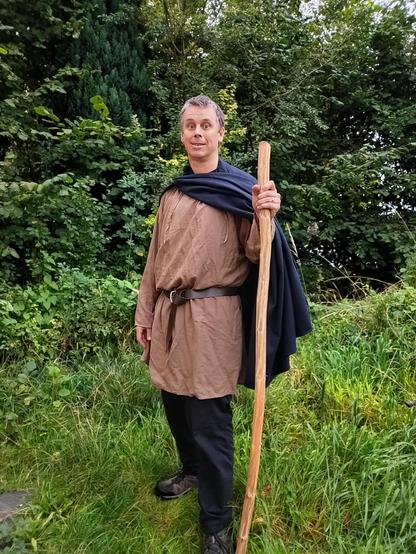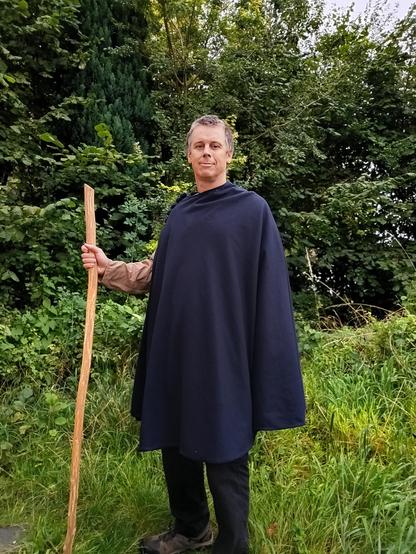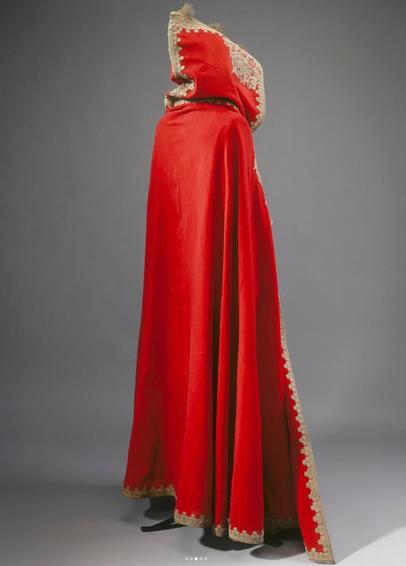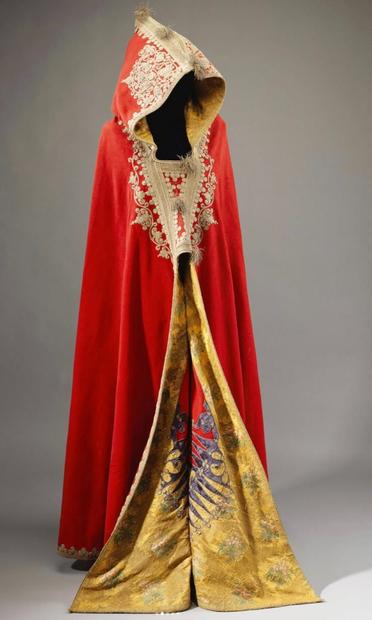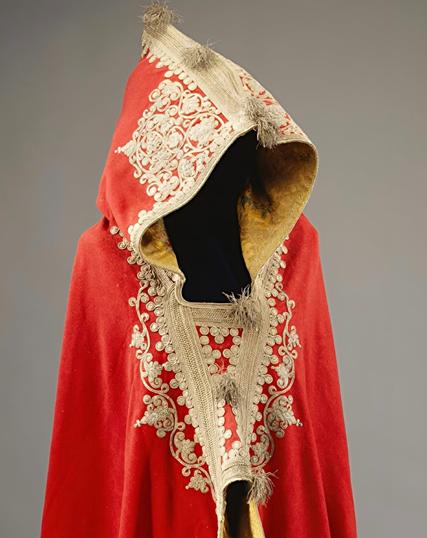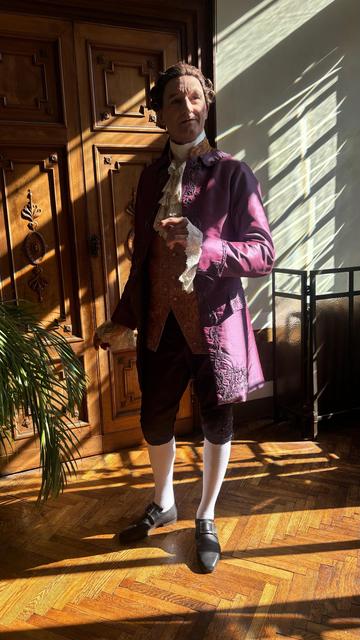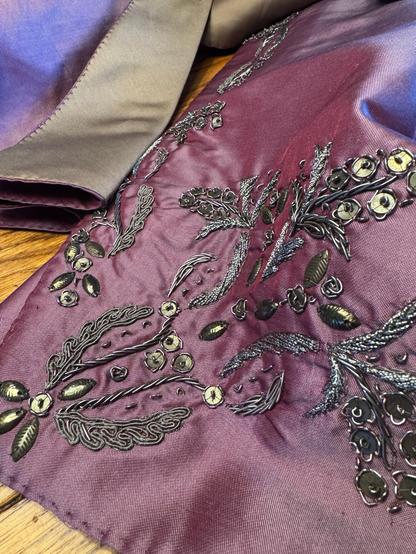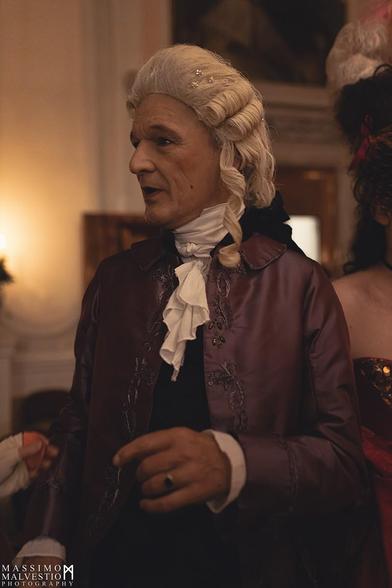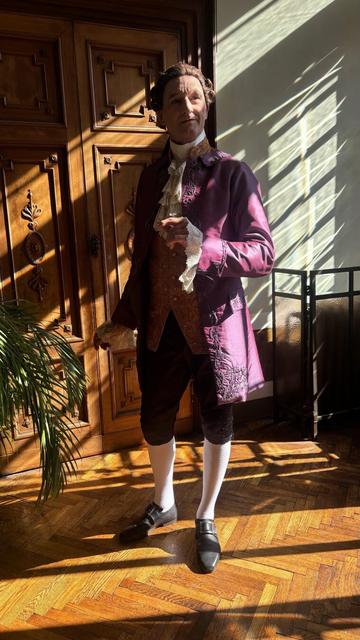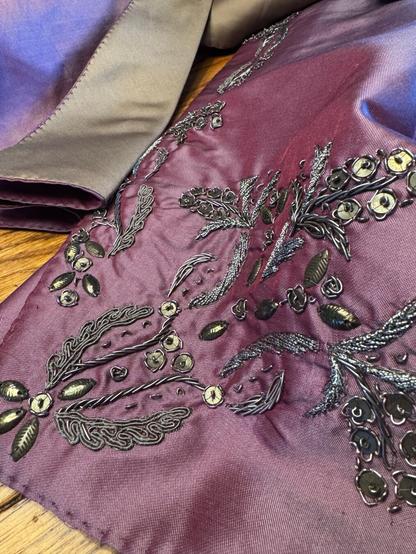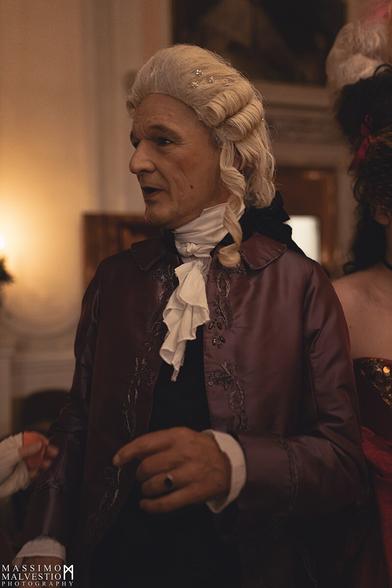Iranian Trousers for Plataea
A glazed brick relief of feet and shins from the palace of Darius I at Susa. Musee du Louvre, Département des Antiquités orientales, number Sb 14426 c/o Achemenet
http://www.achemenet.com/fr/item/?/musee-achemenide/categories-d-objets/architecture/decor-architectural/3018977People representing Median, Persian, or Saka soldiers at Plataea in 2021 will need trousers. Not everyone needs them: the King rules many lands full of all kinds of men, many of whom have not adopted the Median dress. But reenactors representing men (and possibly women?) from those nations will need them.
One kind of evidence to use is artwork. Aside from the reliefs from Persepolis, the goldsmith’s work from Scythian tombs and the Oxus Treasure, and the mosaic from Pompeii which everyone knows, you will want to have a close look at some of the glazed terracottas of servants from Susa in Forgotten Empire: The World of Ancient Persia or on achemenet and of course at the tomb paintings from Tatarlı, Turkey.
By far the most important archaeological find are the trousers of saltman No. 4 from Chehrābād, Iran, radiocarbon dated to around 405-380 BCE. The saltman is still wearing trousers tucked into his shoes and covered by the skirt of his coat, and all of the textiles are so delicate and salt-encrusted that they cannot be removed, spread flat, and examined. What we know can be summarized in the following few sentences:
- The trousers are woollen, tabby weave, 8 z-spun weft threads per cm, 11 s-spun warp threads per cm.
- There are lateral seams in the trouser legs to ankle, and a vertical slit in the lateral thigh at hip level with the skin of the deceased exposed underneath. (Whether the seams are at the medial leg (inner thigh) or lateral leg (outer thigh) is not clear to me)
- A red woollen thread is sewn along the side seams hiding them except at the slit.
- Overall, they strike the excavators as loose and baggy.
There is no published information about stitches, thread, or dye of saltman 4’s trousers (the cloth looks natural white to me). Edit: Dr. Grömer describes the trousers and tunic as “made of a sturdy, plain natural white woollen cloth” (aus robustem einfarbig naturhellem Wollstoff bestehend).
An Achaemenid period salt miner: Salt mummy no. 4, Archaeological Museum Zanjan (photograph: Deutsches Bergbau-Museum). Original source:
http://www.antiquity.ac.uk/projgall/aali333/*** Edit 2019-11-25: Since this was written, I got back in contact with Dr. Grömer and a future post may talk about her understanding of these trousers as described in an article from 2016, Durchdacht gemacht: Die Kleidung eines Salzmannes aus Chehrabad, Iran. Universum Magazin 3/2016, pp. 108-109. She has visited Iran and examined the mummy, I have not! ***
Out of all the trousers more than a thousand years old I have seen published, these look most similar to the Bronze Age trousers from Yanghai tombs M21 and M157 near Turfan in Xinjiang. The first, best-preserved pair have been radiocarbon dated to a 95% confidence interval of 1122-922 cal. BCE; fibres from the second tomb have been radiocarbon dated to 1261-1040 cal. BCE.
The Late Bronze Age trousers from Yanghai, Xinjiang. After Fig. 4 and Fig. 5 in
http://dx.doi.org/10.1016/j.quaint.2014.04.056Similar short trousers (“breeches” in Middle English) are known from graves in the Caucasus region in the 7th to 10th centuries CE. Two are in the Metropolitan Museum of Art (accession number 1999.153.40 and 1999.153.43). There are photos of them while they were more intact in an article by Nobuko Kajitani. These consist of two rectangular legs and a square or diamond-shaped gusset for the crotch. Bishop Timotheos of Ibrim (d. after 1372) in Nubia wore similar trousers of undyed cotton cloth with two rectangular pieces for the legs and a gusset of two right triangles, a slightly larger one in back and a slightly smaller one in front sewed bias to bias. His trousers had drawstrings tied at the centre front not the hips. Today, this style of trousers are known as shalwar and worn in Kurdistan, Afghanistan, and Pakistan.
Information in English or German about the breeches from Tuekta kurgan 1 and the woollen trousers from Alakha-1 site and the Verkh-Kal’djin-2, also in the Altai, is harder to find, but photos and diagrams in the Russian publication show that the short trousers from Verkh-Kal’djin-2 have a piece for each leg and a rectangular or diamond-shaped gusset in the crotch. The Late Bronze Age and Early Iron Age trousers from Chärchän in the Tarim Basin are also said to have been made this way.
Trousers from Late Roman Denmark and Egypt are also known. These have seams up the back of the legs (unlike saltman 4’s trousers) and a wide gusset in the back with a narrow tail between the legs. Because this style of trouser is not documented in the Near East until Roman times, I would avoid it unless you are already good at making Thorsberg trousers.
The Yanghai trousers have a stepped gusset, whereas the Caucasus and Nubian trousers have square or diamond-shaped gussets. A diamond shape is easy to cut but hard to weave, so it probably came into fashion as cut clothing replaced woven-to-shape clothing. Unless your trousers are woven to shape, you should probably try a diamond-shaped gusset.
The upper part of the Chehrābād 4 trousers cannot be examined, and I don’t know of any art which shows this part of trousers in this period. (If you know of a sculpture of topless Scythians wrestling, do share!) Any length from just long enough to cover the hips (like modern “low rider” jeans) to elbow-high (like the trousers in a mid-20th-century suit) could work. The Yanghai M21 trousers are only 104 cm long but have gussets 29 cm long, so a higher waist is probably more plausible than lower. The trousers from the Altai also seem to have high waists.
The Saka Tigraxauda (“Pointed-Hat Saca”) delegation on the Apadana at Persepolis. They carry hose with integral foot coverings and upper garments. Photo by Marco Prins, license
CC 1.0 Universal, c/o
https://www.livius.org/pictures/iran/persepolis/persepolis-apadana/persepolis-apadana-east-stairs/saka-tigrakhauda/Early trousers sometimes end straight at the bottom, sometime have integral booties, and sometimes have a ‘stirrup’ under the heel to pull them tight. Saltman 4’s trousers are mostly hidden and my notes from Dr. Karina Grömer’s lecture in 2016 are a little unclear. The two pairs of trousers from Yanghai seem to end straight, but the hems are are worn and the trousers may have been shortened during their working life. The only artwork I know which could help is this carving of tribute-bearers from the Apadana at Persepolis. In some photos it looks like hose with integral feet, but in other photos there seems to be a right angle between the hanging part and the bottom of the legs. It could show stirrups, but the hanging part is a bit long. Do my gentle readers have any ideas or a better photo?
The same relief with the outline of the upper part of the hose highlighted. Photo by Marco Prins, license
CC 1.0 Universal, c/o
https://www.livius.org/pictures/iran/persepolis/persepolis-apadana/persepolis-apadana-east-stairs/saka-tigrakhauda/In indigenous artwork, Scythian and Median trousers disappear inside the shoes or boots rather than draping on top of them like modern trousers (Greek vase painters sometimes show curly-haired Africans or generic easterners whose trousers have cuffs hanging over the shoes, but neither they nor their customers were trouser-wearers). The bottoms of salt man 4’s trousers are still hidden inside his boots. So whether you chose straight cuffs, strirrups, or booties, any trousers you should make should disappear inside low boots without forming bags around the ankles. Eastern nations like the Arachosians and Sogdians sometimes wear loose trousers but they still disappear inside the shoes.
When Greek artists show the bottoms of leggings, they usually end straight at the ankles, sometimes ‘breaking’ over the top of the foot and sometimes fitting tightly. The clothing in these paintings is very different from the clothing carved at Persepolis or found at Chehrābād (and those places are 1500 miles away), but they are still interesting.British Museum, Registration Number 1837,0609.59 I would cite the British Museum’s Terms of use but I can’t see them without enabling a bunch of Javascripts so just search
https://research.britishmuseum.org/research/collection_online/search.aspxEdit 2022-04-16: Stirrup hose! A white figure
lekythos from Athens, c. 440 BCE c/o Sekunda,
The Persian Army, p. 50 Musée du Louvre, Département des Antiquités grecques, étrusques et romaines, A 256 –
https://collections.louvre.fr/ark:/53355/cl010254777 –
https://collections.louvre.fr/CGUIn a different month, I will make some mockups in cheap linen or cotton, then a good pair or two in wool. But that takes time and money, and as an underemployed researcher in fall application season I do not have much of either.
Help me pay my draper’s bill with a donation on Patreon or paypal.me or even liberapay
Select Bibliography: The most useful books and articles are:
- Aali, Abolfazl / Stöllner, Thomas (eds). (2015) The Archaeology of the Salt Miners: Interdisciplinary Research 2010-2014. Metalla: Forschungsberichte des Deutschen Bergbau-Museums 21.1–2/2014 (Deutsches Bergbau-Museum Bochum) {for sale for about 25 Euros new}
- Beck, Ulrike, et al., “The invention of trousers and its likely affiliation with horseback riding and mobility: A case study of late 2nd millennium BC finds from Turfan in eastern Central Asia,” Quaternary International (2014), http://dx.doi.org/10.1016/j.quaint.2014.04.056
- Elizabeth Crowfoot, “The Clothing of a Fourteenth-Century Nubian Bishop.” In Veronika Gervers ed., Studies in Textile History in Memory of Harold B. Burnham (Toronto: Royal Ontario Museum, 1977) pp. 43-51
- Nobuko Kajitani, “A Man’s Caftan and Leggings from the North Caucasus of the Eighth to Tenth Centuries: A Conservator’s Report,” Metropolitan Museum Journal 36 pp. 85-124 https://www.metmuseum.org/art/metpublications/Mans_Caftan_Leggings_from_Caucasus_8_to_10_C_Conservation_The_Metropolitan_Museum_Journal_v_36_2001
- Krug-Ochmann, Julia Barbara (2014) “Achaemenid and Sassanian Trousers. A short technical description from Douzlakh Salt Mine at Chehr Abad, Iran.” Archaeological Textiles Review 56 pp. 60-64 {free to download}
- Polos’mak, N.V., Barkova, L.L., Костюм и текстиль пазырыкцев Алтая (IV-III вв. до н.З.) / Kostium i tekstil’ pazyryktsev Altaya (IV-III vv. do n. e.) / Pazyryk Altai Costume and Textiles (4th-3rd centuries BCE). Infolio: Novosibirsk 2005 (in Russian) pages 80-85 ISBN 5-89590-051-8 {colour photographs and diagrams of all the clothing and shoes from the Altai including trousers from Alakha-1 and the Verkh-Kal’djin-2}
*** Edit 2019-11-25: And see also Karina Grömer, Durchdacht gemacht: Die Kleidung eines Salzmannes aus Chehrabad, Iran. Universum Magazin 3/2016, pp. 108-109 which I discovered after writing this post! ***
(And honourable mention to Peter Calmeyer’s article “Hose” in the Reallexikon der Assyriologie which covers almost all the artwork available today but was written before archaeological finds were available).
Edit 2019-11-20: Added a photograph of a Red Figure plate showing leggings which end at the ankles.
Edit 2020-06: If you read German and are interested in the cut-and-sewed clothing from the Caucasus, check out Ierusalimskaja, Anna A. Die Gräber der Moscevaja Balka: Frühmittelalterliche Funde an der nordkaukasischen Seidenstrasse (Munich: Editio Maris, 1996)
Edit 2022-04-16: Added an apparent depiction of stirrup hose in the Louvre
Edit 2024-02-17: Tip-o-the-tiara to Carolyn Priest-Dorman of https://stringgeek.blogspot.com/: Aleksei Moskvin published some details on Saltman 4’s textiles for weavers as “Ancient textiles from Chehrabad salt mine,” https://sketchfab.com/3d-models/ancient-textiles-from-chehrabad-salt-mine-10a5f66e3286443c9826d14c80d0e41a (2022). Karina Grömer measured the textiles. I don’t know if these observations have been published in print.
Trousers of saltman 4:
- warp yarn, s twist, 50° twist, yarn thickness 0.5-0.6 mm, 7-8 threads per cm
- weft yarn, z twist, 20-30° twist, yarn thickness 0.5 mm, 22 threads per cm (so it is weft-faced, NB. that sources cited above say 11 weft threads per cm)
Tunic of saltman 4:
- warp yarn is s twist, 50° twist, yarn thickness 0.7-0.8 mm, 8 threads per cm,
- weft yarn is z twist, 20° twist, yarn thickness 0.5-0.6 mm, 30 threads per cm (so it is weft-faced)
This kind of information is very important for spinners and weavers.
#AchaemenidEmpire #ancient #DariusMosaic #historicalClothing #Plataia2021 #trousers
